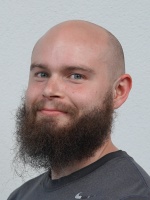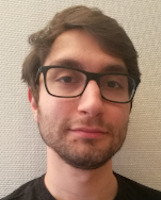Program
13:00 Opening and chair: Trygve Helgaker
13:05 Electronic Structure and Molecular Dynamics in Magnet Fields, Tanner Culpitt
13:35 Multiwavelets, MRChem, and Solvent, Gabriel Gerez
14:05 Break
14:15 Almlöf–Gropen Lecture 2021: There is no time for science as usual: Materials Acceleration Platforms, Alán Aspuru-Guzik
15:00 Closing

Almlöf–Gropen Lecturer, Alán Aspuru–Guzik
Department of Chemistry and Department of Computer Science,
University of Toronto
CIFAR AI Chair, Vector Institute for Artificial Intelligence
Director, Acceleration Consortium (accelerationconsortium.ai)
Co-founder, Kebotix, Inc.
Co-founder, Zapata Computing, Inc.
Alán Aspuru-Guzik is a professor of Chemistry and Computer Science at the University of Toronto and is also the Canada 150 Research Chair in Theoretical Chemistry and a Canada CIFAR AI Chair at the Vector Institute. He is a CIFAR Lebovic Fellow in the Biologically Inspired Solar Energy program. Alán also holds a Google Industrial Research Chair in Quantum Computing. Alán is the director of the Acceleration Consortium, a University of Toronto-based strategic initiative that aims to gather researchers from industry, government and academia around pre-competitive research topics related to the lab of the future.
Alán began his independent career at Harvard University in 2006 and was a Full Professor at Harvard University from 2013-2018. He received his B.Sc. from the National Autonomous University of Mexico (UNAM) in 1999 and obtained a PhD from the University of California, Berkeley in 2004, where he was also a postdoctoral fellow from 2005-2006.
Alán conducts research in the interfaces of quantum information, chemistry, machine learning and chemistry. He was a pioneer in the development of algorithms and experimental implementations of quantum computers and quantum simulators dedicated to chemical systems. He has studied the role of quantum coherence in the transfer of excitonic energy in photosynthetic complexes and has accelerated the discovery by calculating organic semiconductors, organic photovoltaic energy, organic batteries and organic light-emitting diodes. He has worked on molecular representations and generative models for the automatic learning of molecular properties. Currently, Alán is interested in automation and "autonomous" chemical laboratories for accelerating scientific discovery.
Among other recognitions, he received the Google Focused Award for Quantum Computing, the Sloan Research Fellowship, The Camille and Henry Dreyfus Teacher-Scholar award, and was selected as one of the best innovators under the age of 35 by the MIT Technology Review. He is a member of the American Physical Society and an elected member of the American Association for the Advancement of Science (AAAS) and received the Early Career Award in Theoretical Chemistry from the American Chemical Society.
Alán is editor-in-chief of the journal Digital Discovery as well as co-founder of Zapata Computing and Kebotix.
Abstract: There is no Time for Science as Usual: Materials Acceleration Platforms
The world is facing several time-sensitive issues ranging from climate change to the rapid degradation of our climate, as well as the emergence of new diseases like COVID-19. We need to rethink the way we do science and think of it as a workflow that could be optimized. Where are the pain points that can be solved with automation, artificial intelligence, or better human practices? My group has been thinking about this question with an application to the design of organic optoelectronic materials. In this talk, I will discuss the progress in developing materials acceleration platforms, or self-driving labs for this purpose.

Almlöf–Gropen Young Speaker, Tanner Culpitt
Hylleraas Centre, University of Oslo, Oslo Norway
Tanner graduated from the University of Wisconsin-La Crosse in 2014 with a Bachelor degree in chemistry, 2nd and 3rd majors in physics and applied mathematics. After graduating from the University of Illinois at Urbana-Champaign in 2019 with a PhD in chemistry, he joined the Hylleraas Centre as a postdoctoral researcher in 2020.
Abstract: Electronic Structure and Molecular Dynamics in Magnetic Fields
The electronic structure and dynamics of molecules in magnetic fields have historically been treated perturbatively. A perturbative treatment is successful at weaker field strengths, such as those found on Earth. At higher field strengths such as those found in white dwarf stars or neutron stars, a perturbative treatment is inadequate, and new tools are needed to accurately model electronic structure and dynamics. This talk will focus both on the development of these tools, and on the first nonperturbative implementation of ab initio molecular dynamics in strong magnetic fields.

Almlöf–Gropen Young Speaker, Gabriel Gerez
Hylleraas Centre, UiT The Arctic University of Norway, Tromsø, Norway
Gabriel is a Ph.D. working at UiT with MRChem, a numerical real-space code for electronic structure calculations through Multiwavelets. He wrote his master thesis on a cavity-free real-space formulation of polarizable continuum model, which was implemented for MRChem. He began his Ph.D study in 2020, continuing work on PCM. His project has now moved to excitation energies, which will be extended to solvated systems through the PCM framework.
Abstract: Multiwavelets, MRChem and Solvent
Real space methods have long been used for benchmarking, but they are quite susceptible to the curse of dimensionality. Alpert introduced the multiwavelet (MW) basis in the 90s, which have mathematical properties which allow for diminishing the curse of dimensionality. These properties lead to effective adaptive algorithms, sparse representation of operators and functions, and precise error control. These properties lead to MW being well suited for benchmarking of molecular properties. My work has consisted of implementing a solvent framework in MW software MRChem. All systems of interest to chemists are in solvent. One way of modelling solvent systems is by use of polarizable continuum models (PCM). PCM consists of solving the polarization energy on a gaussian surface, called a cavity, surrounding the solute molecule.
This has issues such as discontinuity at the cavity and non-physical assumptions such as the charge density being completely contained inside the surface. In our implementation we defined a diffuse cavity boundary, which better handles the escaped density. This also makes it more flexible as it enables to include more contributions to the solvent energy without much change to the framework.
In this presentation I will give a basic introduction to MW, and I will present PCM and why our group has chosen this particular flavor of solvent model.
